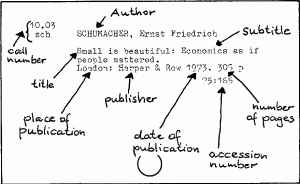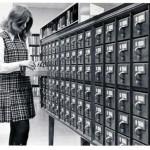Posted by Maeve on Tuesday, Oct 6, 2015
Some of you may never have used a card catalog or touched an actual catalog card, so the news from Dublin, Ohio that OCLC printed its last catalog card may not have meant much to you. To those of us who used catalog cards or took cataloging classes and used a typewriter to create a catalog card, it makes us wistful.
An excerpt from the Columbus Dispatch 10/02/2015 tells the story of the last printed catalog card:

Shortly before 3 p.m. Thursday, an era ended. About a dozen people gathered in a basement workroom to watch as a machine printed the final sheets of library catalog cards to be made by Dublin-based OCLC.
The final tally: 1.9 billion cards.
OCLC long ago shifted its emphasis to online records and services, even changing its name from the Ohio College Library Center to the Online Computer Library Center. The company is known today by its initials.
“We were going to have a monk doing calligraphy on the last card,” joked Skip Prichard, the president and CEO, standing among the observers.
Catalog cards were once a key part of the company, with rows of printers running in a sunny second-floor observatory, hitting a peak output of 131 million cards in 1985. The company’s innovation was in compiling the information on the cards, which meant that libraries didn’t need to write the text themselves. As of last year, orders had fallen to less than 1 million. The final shipment was bound for Concordia College in Bronxville, N.Y., where librarians use the cards as a backup to an online catalog.
 In 1981 the Iowa City Public Library stopped using catalog cards. It was the dawning of a new era in the library world and Iowa City was a pioneer. A 1982 article in Library Journal on the opening of the new Iowa City Public Library titled An Electronic Public Library for Iowa City Connie Tiffany shared the story of how "the library used 14 full-time data entry operators who worked 21.500 hours retyping the bibliographic information for 120,000 items into the online format. Some 10,300 patrons were re-registered .... and in October 1979 the circulation system went online". It wasn't until the new library opened its doors did the physical card catalog finally disappear
In 1981 the Iowa City Public Library stopped using catalog cards. It was the dawning of a new era in the library world and Iowa City was a pioneer. A 1982 article in Library Journal on the opening of the new Iowa City Public Library titled An Electronic Public Library for Iowa City Connie Tiffany shared the story of how "the library used 14 full-time data entry operators who worked 21.500 hours retyping the bibliographic information for 120,000 items into the online format. Some 10,300 patrons were re-registered .... and in October 1979 the circulation system went online". It wasn't until the new library opened its doors did the physical card catalog finally disappear
The first online catalogs were very different from the ones we use today. There was eerie wavering green type on a touch-screen terminal and they were slow; in order to find a title, subject or author the user had to keep narrowing down the search until the title of the item finally appeared. There were eight catalog terminals when the library opened in 1981, today we have 24 online catalog spread throughout the entire library. They are no longer touch screen monitors and the eerie green glow is gone. Their speed is greatly improved and and access to other types of information has increased by the integration of many of the library's online databases into a search.
While I don't want to return to the age of the printed catalog card, I do feel somewhat nostalgic.
 There was magic sometimes in riffling through the cards in the catalog, the mix of the new cards and old, and perhaps even the memory of past searches.
There was magic sometimes in riffling through the cards in the catalog, the mix of the new cards and old, and perhaps even the memory of past searches.

